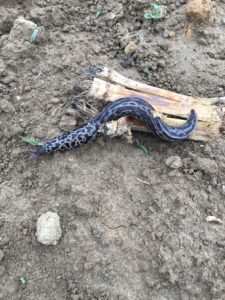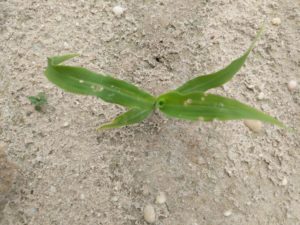Sweet Corn
A few European corn borer (ECB) moths have been captured over the past week, though they are too few in number to generate a map image. While some early corn is now in whorl stage and able to support ECB larvae, adult numbers do not indicate a significant threat as of this week. We expect numbers to increase over the next 2-3 weeks, and will post maps and management suggestions as this occurs.
The highest nightly trap catches of ECB for the week ending 5/27/20 are as follows:
| Asbury 1 | Denville 1 | Milltown 1 |
| Bellemeade 1 | Eldora 1 | Springdale 1 |
| Califon 1 | Hillsborough 1 | Tabernacle 1 |
| Clinton 1 | Milford 1 |
Two corn earworm (CEW) moths were captured this week (Eldora, Cape May County and Port Colden, Warren County) in blacklight traps. It is possible that these individuals overwintered locally, but in any case, they pose no threat to sweet corn at this time.
 There have been fields of seedling stage sweet corn exhibiting signs of slug injury this past week (streaks on leaves with tissue eaten away, but leaving one layer of epidermal tissue). Generally the slugs responsible for this injury are a smaller species than the one in the photo at left. Additionally, corn stem weevils have been discovered this week causing holes in leaves similar to those bill bugs make, but without the linear pattern across the leaf as with bill bug – see photo at right. The former (slugs) have been found in northern counties on heavier soil for the most part, while the corn stem weevil injury is occurring in Cape May County. Slug injury
There have been fields of seedling stage sweet corn exhibiting signs of slug injury this past week (streaks on leaves with tissue eaten away, but leaving one layer of epidermal tissue). Generally the slugs responsible for this injury are a smaller species than the one in the photo at left. Additionally, corn stem weevils have been discovered this week causing holes in leaves similar to those bill bugs make, but without the linear pattern across the leaf as with bill bug – see photo at right. The former (slugs) have been found in northern counties on heavier soil for the most part, while the corn stem weevil injury is occurring in Cape May County. Slug injury  generally decreases as weather warms and the soil surface dries. In rare instances of prolonged cool, wet weather, an application of slug bait may be warranted to limit injury to small plants. In this case, damage should be found on the majority of plants, with slug-favorable weather in the forecast. Corn stem weevil can sometimes causing severe damage from feeding on leaves and stems of seedlings. Adults are small, 1/8-3/16 inch, brown or black mottled. They hide during daylight beneath plants or under debris on the soil surface. In recent years, they have been active only in May and June. Consider an application of a labeled pyrethroid for beetle control in corn if injury is present on 12% or more seedlings. For insecticide recommendations, see the Sweet Corn section of the 2020 Commercial Vegetable Production Guide.
generally decreases as weather warms and the soil surface dries. In rare instances of prolonged cool, wet weather, an application of slug bait may be warranted to limit injury to small plants. In this case, damage should be found on the majority of plants, with slug-favorable weather in the forecast. Corn stem weevil can sometimes causing severe damage from feeding on leaves and stems of seedlings. Adults are small, 1/8-3/16 inch, brown or black mottled. They hide during daylight beneath plants or under debris on the soil surface. In recent years, they have been active only in May and June. Consider an application of a labeled pyrethroid for beetle control in corn if injury is present on 12% or more seedlings. For insecticide recommendations, see the Sweet Corn section of the 2020 Commercial Vegetable Production Guide.
 WASHINGTON, May 26, 2020-–Specialty crops producers can now apply for USDA’s Coronavirus Food Assistance Program (CFAP), which provides direct payments to offset impacts from the coronavirus pandemic. The application and a payment calculator are now available online and USDA’s Farm Service Agency (FSA) staff members are available via phone, fax and online tools to help producers complete applications. The agency set up a call center in order to simplify how they serve new customers across the nation. Applications will be accepted through August 28, 2020.
WASHINGTON, May 26, 2020-–Specialty crops producers can now apply for USDA’s Coronavirus Food Assistance Program (CFAP), which provides direct payments to offset impacts from the coronavirus pandemic. The application and a payment calculator are now available online and USDA’s Farm Service Agency (FSA) staff members are available via phone, fax and online tools to help producers complete applications. The agency set up a call center in order to simplify how they serve new customers across the nation. Applications will be accepted through August 28, 2020.
 Farmer Panel: Tracy Duffield-Duffield’s Farm Market, Dave Specca- Specca’s Pick-Your-Own Farm and Jess Niederer – Chickadee Creek Farm and CSA will discuss what they have changed on their farms due to COVID-19.
Farmer Panel: Tracy Duffield-Duffield’s Farm Market, Dave Specca- Specca’s Pick-Your-Own Farm and Jess Niederer – Chickadee Creek Farm and CSA will discuss what they have changed on their farms due to COVID-19.